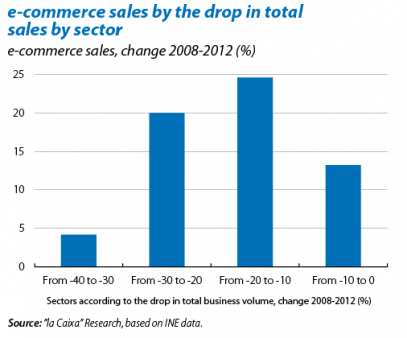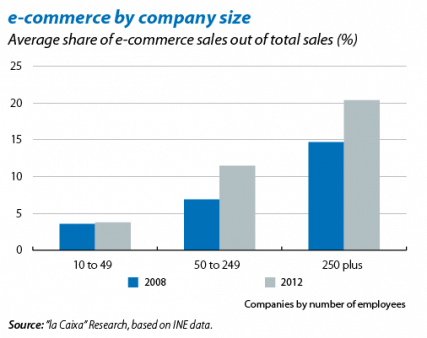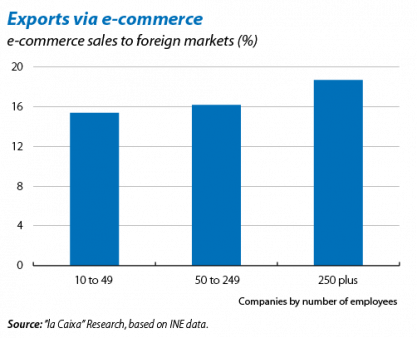e-commerce: an expanding market
Between 2008 and 2012, e-commerce sales(1) grew by 14.2% according to the INE's annual survey on the use of ICTs and e-commerce by firms. This figure contrasts with the trend in total sales which fell by 14.8% in the services sector and by 23.2% in industry over the same period. Even those sectors that experienced the largest drop in their overall business, more than 30%, enjoyed modest growth in online sales. Given the huge growth potential for this distribution channel, in this Focus we analyse the patterns followed by companies employing e-commerce.
The number of firms that have jumped on the e-commerce bandwagon has risen non-stop: in 2012, 14.4% of companies sold via different electronic channels compared with 11.1% in 2008. The business volume generated by these sales totalled 183.1 billion euros, accounting for 14.0% of all sales made by Spanish firms. Penetration by sector is quite uneven: accommodation services top the ranking with 27.4% of the sales via this channel, in contrast with just 1.5% for the real estate sector.
By size, big companies make the largest number of sales online while medium-sized firms have increased their sales the most over the last four years. This partly reflects the fixed costs associated with accessing such technology. As the costs of accessing electronic sales fall, differences due to company size are likely to dissipate.
Once companies have adopted this distribution channel, they use it to broaden their potential market and to internationalise. In 2012, 18% of online sales in Spain were for foreign markets (14.7% to other EU countries and 3.3% outside the EU). It is notable that both large and small firms follow this pattern suggesting that, once the fixed cost of accessing new technology has been incurred, the opportunities arising for internationalisation are similar for all kinds of companies.
Compared with other EU countries, Spanish firms are well positioned: the percentage of firms selling online is similar to the average (14%) and more than in Italy (4%) or France (11%). However, there is still a long way to go to reach the figures of more advanced countries such as Germany (22%) or the Nordic countries (27% in Sweden). Continuing to invest in technology and innovation is the way to achieve the improvements in corporate efficiency that can be provided by e-commerce.
(1) e-commerce is taken to be any transaction carried out via remote networks. Payments and product deliveries may be carried out via these or other means.


